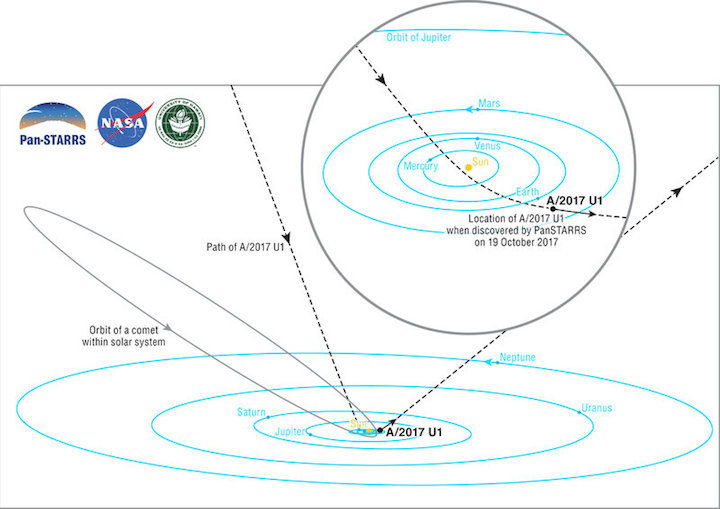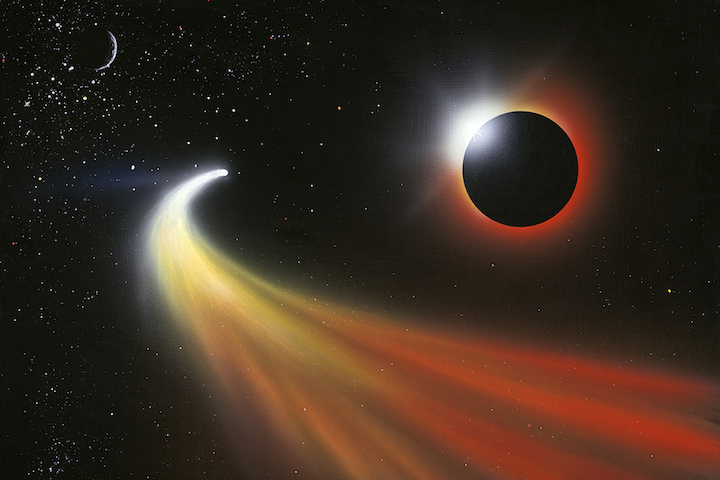Telescopes only picked it up a week ago, but it's likely been traveling through interstellar space for millions of years.
For centuries, skywatchers have chronicled the comings and goings of thousands of comets. Every one of them has come from someplace in our own solar system, either the Kuiper Belt beyond Neptune or the much more distant Oort Cloud at the fringes of the Sun's realm.

Comet PanSTARRS (C/2017 U1) raced within about 0.25 astronomical unit of the Sun in early September and is now relatively close to Earth. Based on its extreme orbit, astronomers believe it arrived here from interstellar space.
NASA / JPL / Horizons
But an object swept up just a week ago by observers using the PanSTARRS 1telescope atop Haleakala on Maui has an extreme orbit — it's on a hyperbolic trajectory that doesn't appear to be bound to the Sun. Preliminary findings, published earlier today by the International Astronomical Union's Minor Planet Center (MPC), suggest that we are witnessing a comet that escaped from another star.
"If further observations confirm the unusual nature of this orbit," notes Gareth Williams, the MPC's associate director, "this object may be the first clear case of an interstellar comet."
Designated C/2017 U1, Comet PanSTARRS was a dim, 20th-magnitude blip when first spotted on October 18th, after having zipped within 37,600,000 km (23,400,000 miles) of the Sun on September 9th. Such a close approach to the Sun's searing heat would ordinarily spell doom for a small comet. Based on its apparent brightness, dynamicist Bill Gray calculates that it would have a diameter of about 160 meters (525 feet) if it were a rock with a surface reflectivity of 10%. "It went past the Sun really fast," Gray notes, "and may not have had time to heat up enough to break apart."
Now it's headed out of the solar system, never to return. It passed closest to Earth on October 14th at a distance of about 24,000,000 km (15,000,000 miles), and astronomers worldwide have been tracking it in the hopes of divining its true nature — especially whether it's displaying any cometary activity.
What gives C/2017 U1 away as an interstellar visitor wasn't its very high inclination (122°) with respect to Earth's orbit, which isn't particularly rare, but more critically its extreme hyperbolic eccentricity (1.19). Check out the comet's pass through the inner solar system using JPL's interactive Horizons app (requires Java).

Here's how Comet PanSTARRS (C/2017 U1) looked on October 21st as recorded at Tenagra Observatory near Rio Rico, Arizona. The images span 9 minutes, during which time the telescope tracked the object's motion, so background stars appear trailed. Each field is 3 arcminutes wide with north up.
Paulo Holvorcem & Michael Schwartz (NASA grant #NNX15AE89G)
Dynamicists had previously calculated how often comets and asteroids from other stars should be in our midst. However, the only other comet suspected to have an interstellar origin was Comet Bowell (C/1980 E1), which had an eccentricity near 1.05. However, notes S&T Senior Contributing Editor Roger Sinnott, "Comet Bowell apparently was not hyperbolic on the way in, but only as it left" because that object passed within 35,000,000 km (0.23 a.u.) of Jupiter, whose gravity gave it a boost in speed.
According to Gray, Comet PanSTARRS appears to have entered the solar system from the direction of the constellation Lyra, within a couple of degrees of right ascension 18h 50m, declination +35° 13′. That's tantalizingly close to Vega — and eerily reminiscent of the plot of the movie Contact — but its exact path doesn't (yet) appear to link any particular star.
This object entered the solar system moving at 26 km (16 miles) per second. At that speed, in 10 million years it would traverse 8,200,000,000,000,000 km — more than 850 light-years.
Quelle: Sky&Telescope
---
Update: 27.10.2017
.
Scientists Spot First Alien Space Rock In Our Solar System

Diagram of the path of a space rock from outside our solar system — the first ever observed.
Astronomers have spotted some kind of outer space rock that's the first visitor from outside of our solar system that they've ever observed.
The discovery has set off a mad scramble to point telescopes at this fast-moving object to try to learn as much as possible before it zips out of sight.
"Now we finally have a sample of something from another solar system, and I think that's really neat, " says Karen Meech, an astronomer at the University of Hawaii Institute for Astronomy, "and so you'd love to see if it looks like stuff in our solar system."
It's long been assumed that an interstellar object like this one should be out there, because giant planets in forming solar systems are thought to toss out bits of space crud that haven't yet glommed into anything. But this is the first time scientists have actually found one.
The mysterious object is small — less than a quarter mile in diameter — and seems to have come from the general direction of the constellation Lyra, moving through interstellar space at 15.8 miles per second, or 56,880 miles per hour.
"The orbit is very convincing. It is going so fast that it clearly came from outside the solar system," says Paul Chodas, manager of NASA's Center for Near-Earth Object Studies at the Jet Propulsion Laboratory in Pasadena, Calif. "It's whipping around the Sun, it has already gone around the Sun, and it has actually gone past the Earth on its way out."
The asteroid was discovered on October 19 by Hawaii's Pan-STARRS 1 telescope, which searches the sky for near-Earth objects.
"It became clear that it didn't move like asteroids and comets normally do," says Robert Weryk of the University of Hawaii, who contacted a colleague to acquire follow-up images using another telescope owned by the European Space Agency. The combined observations made it clear that this was an interstellar visitor.
The asteroid is now speeding toward the constellation Pegasus and is fading out of sight fast. "We might have, for moderately large telescopes, another handful of days, maybe a couple of weeks. So we don't have much time to study it," says Meech, who wants to know what its shape is and what its chemical composition might be. She says the Hubble Space Telescope should spy on this object as well, in the coming weeks.
She notes that different stars have different chemical compositions, so she'd like to know if the solar system this came from produces material similar to the planet-making stuff in our own.
"We've been expecting this for decades, really," says Chodas. "We don't know enough about how much material is floating around between the stars. And so this will give us the first data point. We hope to find more of this stuff."
Quelle: npr
+++
Scientists detect comets outside our solar system
Team of professional and citizen scientists identifies tails of comets streaking past a distant star.

Scientists from MIT and other institutions, working closely with amateur astronomers, have spotted the dusty tails of six exocomets — comets outside our solar system — orbiting a faint star 800 light years from Earth.
These cosmic balls of ice and dust, which were about the size of Halley’s Comet and traveled about 100,000 miles per hour before they ultimately vaporized, are some of the smallest objects yet found outside our own solar system.
The discovery marks the first time that an object as small as a comet has been detected using transit photometry, a technique by which astronomers observe a star’s light for telltale dips in intensity. Such dips signal potential transits, or crossings of planets or other objects in front of a star, which momentarily block a small fraction of its light.
In the case of this new detection, the researchers were able to pick out the comet’s tail, or trail of gas and dust, which blocked about one-tenth of 1 percent of the star’s light as the comet streaked by.
“It’s amazing that something several orders of magnitude smaller than the Earth can be detected just by the fact that it’s emitting a lot of debris,” says Saul Rappaport, professor emeritus of physics in MIT’s Kavli Institute for Astrophysics and Space Research. “It’s pretty impressive to be able to see something so small, so far away.”
Rappaport and his team have published their results this week in the Monthly Notices of the Royal Astronomical Society. The paper’s co-authors are Andrew Vanderburg of the Harvard-Smithsonian Center for Astrophysics; several amateur astronomers including Thomas Jacobs of Bellevue, Washington; and researchers from the University of Texas at Austin, NASA’s Ames Research Center, and Northeastern University.
“Where few have traveled”
The detection was made using data from NASA’s Kepler Space Telescope, a stellar observatory that was launched into space in 2009. For four years, the spacecraft monitored about 200,000 stars for dips in starlight caused by transiting exoplanets.
To date, the mission has identified and confirmed more than 2,400 exoplanets, mostly orbiting stars in the constellation Cygnus, with the help of automated algorithms that quickly sift through Kepler’s data, looking for characteristic dips in starlight.
The smallest exoplanets detected thus far measure about one-third the size of the Earth. Comets, in comparison, span just several football fields, or a small city at their largest, making them incredibly difficult to spot.
However, on March 18, Jacobs, an amateur astronomer who has made it his hobby to comb through Kepler’s data, was able to pick out several curious light patterns amid the noise.
Jacobs, who works as an employment consultant for people with intellectual disabilities by day, is a member of the Planet Hunters — a citizen scientist project first established by Yale University to enlist amateur astronomers in the search for exoplanets. Members were given access to Kepler’s data in hopes that they might spot something of interest that a computer might miss.
In January, Jacobs set out to scan the entire four years of Kepler’s data taken during the main mission, comprising over 200,000 stars, each with individual light curves, or graphs of light intensity tracked over time. Jacobs spent five months sifting by eye through the data, often before and after his day job, and through the weekends.
“Looking for objects of interest in the Kepler data requires patience, persistence, and perseverance,” Jacobs says. “For me it is a form of treasure hunting, knowing that there is an interesting event waiting to be discovered. It is all about exploration and being on the hunt where few have traveled before.”
“Something we’ve seen before”
Jacobs’ goal was to look for anything out of the ordinary that computer algorithms may have passed over. In particular, he was searching for single transits — dips in starlight that happen only once, meaning they are not periodic like planets orbiting a star multiple times.
In his search, he spotted three such single transits around KIC 3542116, a faint star located 800 light years from Earth (the other three transits were found later by the team). He flagged the events and alerted Rappaport and Vanderburg, with whom he had collaborated in the past to interpret his findings.
“We sat on this for a month, because we didn’t know what it was — planet transits don’t look like this,” Rappaport recalls. “Then it occurred to me that, ‘Hey, these look like something we’ve seen before.’”
In a typical planetary transit, the resulting light curve resembles a “U,” with a sharp dip, then an equally sharp rise, as a result of a planet first blocking a little, then a lot, then a little of the light as it moves across the star. However, the light curves that Jacobs identified appeared asymmetric, with a sharp dip, followed by a more gradual rise.
Rappaport realized that the asymmetry in the light curves resembled disintegrating planets, with long trails of debris that would continue to block a bit of light as the planet moves away from the star. However, such disintegrating planets orbit their star, transiting repeatedly. In contrast, Jacobs had observed no such periodic pattern in the transits he identified.
“We thought, the only kind of body that could do the same thing and not repeat is one that probably gets destroyed in the end,” Rappaport says.
In other words, instead of orbiting around and around the star, the objects must have transited, then ultimately flown too close to the star, and vaporized.
“The only thing that fits the bill, and has a small enough mass to get destroyed, is a comet,” Rappaport says.
The researchers calculated that each comet blocked about one-tenth of 1 percent of the star’s light. To do this for several months before disappearing, the comet likely disintegrated entirely, creating a dust trail thick enough to block out that amount of starlight.
Vanderburg says the fact that these six exocomets appear to have transited very close to their star in the past four years raises some intriguing questions, the answers to which could reveal some truths about our own solar system.
“Why are there so many comets in the inner parts of these solar systems?” Vanderburg says. “Is this an extreme bombardment era in these systems? That was a really important part of our own solar system formation and may have brought water to Earth. Maybe studying exocomets and figuring out why they are found around this type of star … could give us some insight into how bombardment happens in other solar systems.”
The researchers say that in the future, the MIT-led Transiting Exoplanet Survey Satellite (TESS) mission will continue the type of research done by Kepler.
Apart from contributing to the fields of astrophysics and astronomy, Rappaport says, the new detection speaks to the perserverence and discernment of citizen scientists.
“I could name 10 types of things these people have found in the Kepler data that algorithms could not find, because of the pattern-recognition capability in the human eye,” Rappaport says. “You could now write a computer algorithm to find this kind of comet shape. But they were missed in earlier searches. They were deep enough but didn’t have the right shape that was programmed into algorithms. I think it’s fair to say this would never have been found by any algorithm.”
This research made use of data collected by the Kepler mission, funded by the NASA Science Mission directorate.
Quelle: MIT News Massachusetts Institute of Technology

